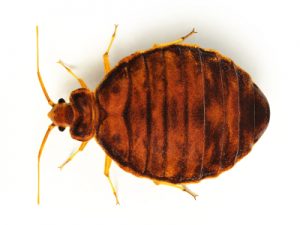Scientific Name: Cimex lectularius
Common Name: Bed bug
Color: range from yellowish –white – 1st instar to a brown to reddish-brown, adult stage
Size: 4 – 5 mm long (3/16 inch)
FACT: Bed bugs do not transmit any known human diseases. Some people will react to the saliva from the bite and have an allergic reaction. Not all people will react to a bed bug bite.
HABITS
Bed bugs are oval in shape with a flat body and a short, broad head. Shaped similar to an apple seed, adults are approximately 3/16” (4 to 5mm) long. First instar nymphs are yellowish white in colour, as they move through the five nymphal instars their cuticle or exoskeleton becomes reddish brown due to the blood staining the cuticle. The upper body surface is covered with short, golden hairs. They can be introduced into a structure via used furniture, items, clothing, computer, or in belongings of someone who has been living in a bed bug infestation. With people travelling more than ever, bed bugs are often transported via luggage and articles of clothing from hotels back to people’s homes. Bed bug infestations have been found in transportation vehicles such as boats, trains, airplanes and buses as well as in retail stores and movie theatres where they typically harbour in the seats and associated frames. Bed bugs do not discriminate. You can be the cleanest or live in filth; anyone can have or get bed bugs.
• Feeding: Generally bed bugs feed at in the dark, but they will feed at any time when a host is present. They will crawl considerable distances to obtain a blood meal. Adults can survive approximately 3 months without feeding on a blood meal, depending on environmental conditions.
• Hibernation: Bed bugs do not hibernate, they slow down their metabolism and wait for the cues of heat and carbon dioxide to attract them to their host. A host is primarily man but they will feed on other animals such as dogs, cats, pigeons, lizards, chickens, pigs to name a few..
• Harbourage Zones: Typically they can be found around mattress buttons and bedding, in box springs or their coverings; and in any many cracks or crevices. Other places to check for bed bugs are picture frames, night stands, baseboards, floorboards, behind loose wallpaper, light switches, door and window frames, conduits, wall voids, attics and other enclosed places. You must look everywhere.
• Reproduction: The female bed bug will lay approximately 200 eggs over her lifetime, and will deposit them mostly into cracks and crevices as well as many other hidden locations. Eggs will hatch within 10 – 14 days under normal conditions. Bed bug eggs are white, approximately 1mm long (1/25 inch), and are very small and only the trained eye of an inspector or a registered bed bug dog can detect bed bug eggs on most surfaces.
CONTROL
A thorough inspection is crucial. Treatment for any bed bugs found is only to be done by a licensed applicator using an appropriately labelled pesticide. Mattress and box spring encasements should be used. In apartment buildings and hotels, it’s advisable to also inspect units to either side, above, below and across from the infested unit. Treatments will occur every 10-14 days after the initial chemical program.
Do not self-treat. Contact a pest control company to positively identify and set up a control program. Only professionals treat with the appropriately commercially labelled pesticides.
Control of bed bugs involves co-operation with home owners and/or tenants. Depending on size of infestations found, multiple treatments may be needed. Treatments occur in cracks and crevices, night stands, baseboards, floorboards, door and window frames, behind loose wallpaper, stuffed furniture, attics and other enclosed places, with properly labelled residual insecticide. Professional will use insecticidal residual dusts in wall voids, light switches, conduits and under carpet seams.
Heat treatments have the highest success rate in eliminating all life stages of bed bugs. Clothes or bedding that may be contaminated with bed bugs should be put in the dryer at the highest temperature setting. Dry, clean items can be put in the dryer on high heat for a minimum of 15-20 minutes in a normal size load. Increase the time based on the size of materials.
Vacuums are a great way to physically remove bed bugs from an area. Be sure to vacuum cracks and crevices where bed bugs like to hide. Also, when finished vacuuming, immediately seal and throw away the vacuum bag or if it’s an empty canister type, to clean it out into a garbage bag and wash out with hot water to an outdoor garbage can and have a pest management professional treat your home and belongings.
Please contact Poulin’s for further bed bug information or if you have further questions. Please remember not to self-treat. You will likely cause more of a problem by spreading the bed bugs out even further in your home, suite, or apartment building.

